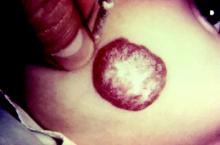Topical timolol maleate acts as an effective alternate to oral propranolol for treatment of certain infantile hemangiomas (IHs), based on data from a retrospective study of 731 children. The findings were published online August 15 in Pediatrics.
“Superficial, relatively thin IHs, regardless of pretreatment surface or body site, are likely to respond reasonably well to several months of treatment with modest, but definite improvements in color and size,” wrote Katherine Püttgen, MD, of Johns Hopkins University in Baltimore, Md., and colleagues in the Hemangioma Investigator Group (Pediatrics 2016;138:e20160355 [doi: 10.1052/peds.2016-0355]).
Although topical timolol maleate (TTM) has been used off label to treat infantile hemangiomas since 2010, “there is very limited information regarding off-label safety and pharmacokinetic data when used on hemangioma-affected skin,” the researchers noted.
The researchers reviewed data from 731 children treated at nine pediatric centers in the United States. Patients were treated for at least 30 days; the average treatment duration was 9 months. Most of the children (41%) began treatment between ages 0 and 3 months, and 86% were treatment naïve.
About 85% of the children received TTM 0.5% GFS (gel-forming solution), with parents instructed to apply 1 drop twice daily to the IH; 15% were prescribed 4 drops or more of TTM daily. Treatment response was assessed based on visual analog scales for color (VAS-C) and for size, extent, and volume (VAS-SEV).
Overall, 70% of children showed improvement of at least 10% from baseline on the VAS-C after 1-3 months of treatment, and 92% showed meaningful improvement from baseline after 6-9 months of treatment. VAS-SEV scores improved at least 10% from baseline in 39% of children after 1-3 months and meaningful improvement in 76% after 6-9 months.
Independent predictors of treatment success included longer treatment time and thinner, superficial IH at baseline.
Adverse events were observed in 3% of the patients, approximately half of which were reports of scaly skin. No patients discontinued the study because of adverse events, and no cardiovascular adverse events were reported.
The results were limited by several factors including the lack of controls and the retrospective nature of the study, the researchers noted. In addition, they cautioned against the use of However, the findings suggest that “TTM can be recommended as an initial, and often sole, treatment modality for many relatively superficial His without aggressive growth or threat of functional impairment,” they said. However, the researchers cautioned against TTM in cases of ulcerated IHs because of the potential for increased drug absorption.
Dr. Püttgen and several coauthors disclosed serving as consultants to Pierre Fabre.


